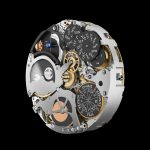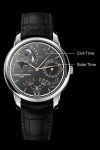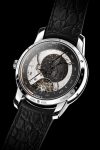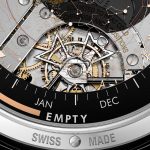Reviews
Vacheron Constantin Les Cabinotiers Celestia Astronomical Grand Complication 3600 — A Starring Role
(Seriously, though, where’s all this coming from? You don’t see it elsewhere — no one’s going, like, “This is the best dish ever, it has 85 ingredients!” “This movie ought to win all the awards, it has 33 action sequences!” “I love this dope-ass book because it has 28 plotlines.” Logic — we have it, let’s use it.)
The Celestia tells us mean solar time (also known as civil time), solar time and sidereal time. Civil time is regular, metronomic; you literally set your watch by it. That’s because it’s an entirely manmade construct. That’s pretty much all there is to it.
Solar time is irregular but predictable, kind of like weather cycles, or menopause. Most natural phenomena, basically. This is because Earth is a big bitch, and instead of behaving in ways that would give us perfectly consistent time units — circular heliocentric orbit with an axis of rotation perpendicular to the orbital plane — went and did the total opposite of all those things. Earth is like the primary school teacher making you do your mathematics homework during recess; she doesn’t believe in making things easy for you. Then again, Earth’s refusal to play ball is also what gives us the different seasons and other fun things like tropical beaches and ski slopes, so I guess it’s swings and roundabouts (unfortunate choice of phrase for the kid who was kept in during recess).
The sidereal day is slightly shorter than the solar day for a pretty straightforward reason, which I’m not going to go into. You can watch this YouTube video for an explanation though. It’s made by smart people who actually do science for a living, so you’re in good hands there.
Compared to the 24-hour solar day (mean), the sidereal day clocks in at 23 hours, 56 minutes and 4 seconds, making it a sidereal day 0.997 times the length of a solar day. That’s an approximation; the actual figure has like eight decimal places at least — could be more, my calculator display ran out of space.
The oscillator of the Celestia beats at 2.5Hz (18,000vph), which means it can accurately measure a fifth of a second. All these fifths of a second that are being chopped up by this oscillator are then gathered up and turned into readings of mean solar seconds, minutes and hours by established gear systems that they teach you in watchmaking kindergarten.
The display of sidereal time requires a dedicated gear train that does nothing else. Because of the insane ratios that go with translating solar time units into sidereal time units, it’s easier to derive the sidereal day first and then use multiplying gears to break it down into hours, minutes and seconds. It can be done the other way around too, but the kind of person who’d do that is probably also the kind of person who answers personal ads from the Marquis de Sade whilst keeping weekends free for Christian Grey.
So that’s what Celestia does, as far as sidereal time goes. Now we get to the interesting part. What did I tell you? This watch lit AF.
Related Notes + Observations
– The 122-year-accurate moonphase display is pretty awesome too, simply because the synodic cycle (lunar cycle) doesn’t run in neat multiples of civil time either. The Celestia is like the horological United Nations (only vastly more successful), bringing together different systems of time to form a coherent whole vibrating at a single frequency.
– The Celestia has a power reserve of three weeks over six barrels, which is pretty damn impressive, since your regular old single-barrel time-only ticker gives out within two days.
– Obviously, since the Celestia is a unique piece, there aren’t gonna be a whole lot of people who get to own this watch, but I like to think that its triple-time concept relates to the different ways that a person can engage with the surrounding universe: civil time for our practical, get-shit-done side; solar time for our wider embrace of the world and its quirks, irregularities, its problems; sidereal time for dreaming big and reaching out with our eyes on the stars.
– You might have expected a bit more chat about some of the Celestia’s other functions, like the indications of tide, sunrise, sunset, all that stuff, but to be honest they’re peripheral cam-driven displays that run off the civil-time gear train. While they are cool, they just aren’t as conceptually interesting as the sidereal time display. Also, I’m shifting my discussion of the functions related to the solar (tropical) year indications to a separate article.
– I haven’t talked about the design of the Celestia at all! I wonder if there’s another watch that I’ll use to frame the expertise of Vacheron Constantin in the aesthetic domain…
















